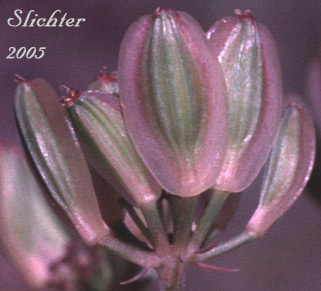Nine-leaf desert parsley is a perennial wildflower with one to a few erect stems arising from 20-80 cm high from a narrowly thickened, elongate taproot. The herbage is covered with fine, short but stiff hairs. The leaves are mostly basal, although some may be present at the middle or upper parts of the stems. The leaves are ternately or ternate-pinnately compound 2-3 times, and cleft into long, narrow segments or leaflets from 1-10 cm long.
The inflorescence is an umbel with 6-18 branches of unequal length supporting the umbellets, these stems measuring up to 2-10 cm long. The flowers are yellow. The fruits are broadly elliptic with broad wings about as wide as the body of the fruit. The fruits measure from 7-15 mm long and 3-7 mm wide. The bracts below the umbelets are inconspcuous, filiform in shape when present, or are absent.
Nine-leaf desert parsley could be confused with slender-fruited desert parsley (L. leptocarpum). The latter species has roots that have elongated or beaded swellings while the former has thick roots which lack the swellings. The latter species is also often 4 times pinnately compound with shorter leaf segments, while the nine-leaf desert parsley is tri-pinnately compound with longer, leaf segments. Nine-leaf desert parsley could also be confused with some varieties of the other nine-leaf desert parsley (L. triternatum) of which it once was classified with.
Nine-leaf desert parsley may be found on open slopes and in dry to fairly moist soil in meadows from the lowlands to moderate elevations in the mountains.
Nine-leaf desert parsley may be found from southern British Columbia south through Washington and Oregon on both sides of the Cascade Mts. to California and east to southern Alberta, Montana, Colorado and Utah.
